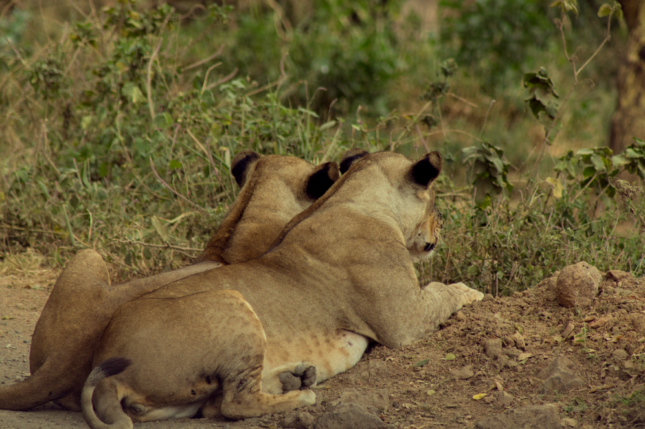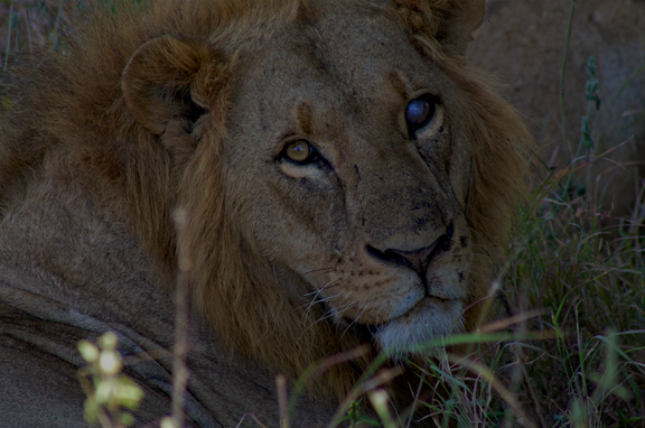How scats might save the cats
On januari 2021 it seemed like Artis, the oldest zoo in the Netherlands, was going to have to say goodbye to its lions. Why? And how can we solve it?
In January 2021 it seemed like Artis, the oldest zoo of the Netherlands, would have to say goodbye to its lions. After the impact of the coronavirus on the financial situation of the zoo, the planned renovation of the lion enclosure did not seem possible, and plans were made to ship the lions elsewhere. Luckily, young and old showed their love for the animals by donating to the zoo to make sure the lions could stay, and with result: recently, it became clear that enough money was gathered to build the new lion enclosure. This is a story with a happy ending, but unfortunately, compared to the lions in Artis, things are not looking good for lions in the wild. There are only 20.000 lions living in the wild, and both in Africa and Asia, lion populations keep declining. A good conservation approach is needed, or else we risk losing the lion as a species. In a large project set up by Kevin Groen, Dr. K.B Trimbos and Prof. Dr. Hans de Iong from the CML performed in collaboration with the Kenya Wildlife Service, students have taken it upon themselves to research aspects of the lion’s biology that are crucial for its conservation. Their studies have an unusual thing in common: they use the faeces, or scats, of the lions in their research. Kevin Groen explains why he set up this project:
Lions live in National Parks, which are sometimes surrounded by fences. Opinions about the impact of these fences on lion populations in the parks are divided. Some say that the only way to conserve the species is through these fences, since they prevent conflicts between humans and lions, such as livestock predation. On the other hand, many scientists claim that putting fences around National Parks influences the lion populations negatively, due to the ecological disturbances such an abrupt separation cause. The long term ecological effects of these fences are not known. We performed an explorative study on multiple parks, both with and without fences, in which we tried to gain insight in the differences between those parks and the dietary behaviour of the lions within. This was done using the scats of the lions. By researching the differences between parks, differences over time, and the possibilities that scat research provides, we can gain more knowledge on how to protect the species.

Research on animal scats is often implemented in dietary research. Although it might not sound like the most appetizing , it certainly is one of the most practical ways to research the lion diet. Faeces are filled with a myriad of information with which many hidden aspects in a lion’s life can be discovered. The scats contain both indigestible parts of prey species and their DNA, which grants knowledge that is the key to proper conservation management. Moreover, the use of scats is non-intrusive, so no lions are harmed or stressed. One of the researchers working on the project that has successfully used scats to research diet of lions is Amy Montanje. The MSc student studied the influence of buffalo abundance on the diet of lions in Lake Nakuru National Park in Kenya, one of the fenced parks, during her internship and found that there is a shift towards smaller prey in areas where buffalo are abundant:
Buffalo are among the most hunted animals eaten by lions, so it might sound a little strange that a bigger buffalo population would translate to a decrease in lions. I was able to calculate that the ratio of buffalo eaten by the lions is indeed lower than expected. I wanted to see whether the lions might shift toward prey species that are less normal for them to hunt on. Smaller animals such as mongoose, lizards, and birds. This is something that we were able to observe, and which can be explained due to the fact that the buffalo are harder to catch in a large herd and even might attack the lions. In one of the adjacent parks, the situation was completely different, with a lower buffalo population and an increase in lions due to migration.
Amy was able to study the diet of the lions by looking at the number of carcasses found around lion footprints, the prey hair and DNA that is present in the faeces of lions:
Hair analysis is a method that is often used in dietary research, but it is a real challenge to identify a specific prey species with just hair. Misidentification happens quickly and many species are missed, since there is a smaller chance the hair of a small prey is sampled compared to bigger species eaten. Reptiles are missed as well since they do not have hair. Carcass research partly helps to complete the dietary picture, but again, smaller carcasses are hard to spot. There is also always a chance the lion itself did not kill the carcass since lion tracks around the carcass are observed, but not the kill itself. We wanted to see whether we could map the diet using DNA analysis. We were not sure whether this was possible since DNA degrades quickly. Luckily, using droplet digital PCR, which is a sensitive method, we were able to see whether a sample was positive for a species or species group.
Droplet digital PCR (ddPCR) is a technique that is ideal for research such as Amy’s, because it is very accurate and sensitive. Amy used this method to research the different small prey species in the diet of the lions using mitochondrial DNA.
Often there is just a little amount of DNA present in the faeces, so a sensitive method is very important. In this method, DNA is divided over 20.000 oil droplets, mini samples. After that, the DNA is amplified using a PCR reaction. For every droplet, the presence of a positive signal is measured, and with this the amount of DNA can be quantified, even if the sample contains only a few DNA molecules.

Monica Chege, a PhD student, is currently studying the lion diet in Kenya. She uses a technique called metabarcoding instead of ddPCR to analyse the presence of DNA in scats:
A big advantage of this particular method is the ability to identify the diversity of species in a sample instead of focussing on one species per reaction. This method is more profound because I am not researching the presence of one species, but rather the total picture. Metabarcoding has been used in other scat research, and the results were positive. Droplet digital PCR is good for an analysis in which the quality of the DNA is low, so for some areas I might consider adopting the approach. Dietary scat research is a rather new area of research, so it is prudent to use different methods.
Monica uses the prey DNA found in scats of multiple parks. She focuses on possible differences in diet introduced by time, by looking at data gathered in 2019 and 2021. Her research is especially important for the future of lions coexisting with humans as well:
As we continue developing as a country, wildlife, livestock and humans come into closer contact with each other, often resulting in conflict incidents. It is important we are aware of the changes we are going through, and the interaction between humans, their livestock and lions. If we look at parks that are closer to human habitations, it is inevitable that livestock will go into national parks. As they go in, they can affect the prey population inside, for instance by increasing the competition for food. This may cause reduction of wild prey species. At the same time, lions are opportunistic carnivores and go for the easiest kill, which is the livestock. If you are closer to human habitation, it is important to research: are the lions eating more livestock or do they eat more wild prey? With this in mind, you can give management recommendations to reduce lion–human conflict.

Sam Boerlijst, a PhD student currently working on population dynamics of mosquitos, used the scats during his MSc to focus on the lions themselves rather than their prey:
I worked on a side project during the project Amy was working on. I wanted to find out whether it is possible to differentiate between individual lions by looking at differences in the DNA present in the faeces. By doing this, we would be able to find out the specifics of the individual. Does an individual prefer specific types of prey, is this dependent on their place in the pride, their sex, or their age? If parasites are found in a scat, and a lion needs special care, it would be a lot easier to locate the specific lion if we could genotype it using the DNA in the faeces. With genotyping, it would even be possible to find out the population size of the animals without following the individuals themselves.
His project unfortunately did not work out the way he intended:
Although some samples did bear results, overall, there was too little nuclear DNA present in the samples. The samples were gathered with the prey DNA research in mind, because of which only a small part of the surface of the faeces was sampled. The outside of the sample contains most of the predator DNA, which is needed for genotyping, while the inside of the faeces is preferred for the dietary research in which prey DNA is needed.

Knowing that the problems he encountered are easily solvable by using a different sampling method, Sam believes that genotyping lions using faecal DNA is possible and are able to contribute to proper conservation management. These different approaches show the incredible uses of something that initially just seems waste. “The usage of scats allows us to look at both the more general ecology of lions and to monitor the health of individuals in a non-intrusive way. With this, conservational management can be optimised.” Sam adds. Using scat research to optimise conservation management is definitely something that we need to implement to give the lions in the wild the happy ending they deserve, just like the lions in Artis. We have a large task ahead of us, but who knows? In the end the cats might be saved by their own scats.
Sources:
- WWF (z.d.) “The magnificent lion: the symbol of Africa. Consulted on June 22, 2021, from https://www.wwf.org.uk/learn/wildlife/african-lions
- Sijtsma, T. (28-01-2021). “Artis doet leeuwen weg vanwege coronacrisis”. Consulted on June 21, 2021, from https://www.parool.nl/amsterdam/artis-doet-leeuwen-weg-vanwege-coronacrisis~b11947c9/
- Roele, J. (04-02-2021). “Leeuwen blijven voorlopig toch in Artis”. Consulted on June 21, 2021, from https://www.parool.nl/amsterdam/leeuwen-blijven-voorlopig-toch-in-artis~b1a33113/
- Photos: S.P. Boerlijst & A.E. Montanje



0 Comments
Add a comment